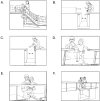Learning to Move
- PMID: 19305638
- PMCID: PMC2658759
- DOI: 10.1111/j.1467-8721.2008.00577.x
Learning to Move
Abstract
Locomotion-moving the body from place to place-is one of infants' greatest achievements. In addition to conquering gravity, infants must cope with variable and novel constraints on balance and propulsion. At the same time that they are learning to move, changes in infants' bodies, skills, and environments change the biomechanical constraints on movement. Recent work highlights both flexibility and specificity in infants' responses to novel and variable situations, demonstrating that infants are learning to learn as they master locomotion. Within sitting, crawling, cruising, and walking postures, experienced infants adapt their locomotor responses to the current biomechanical constraints on movement. However, what infants have learned about coping with variability and novelty in earlier-developing postures does not transfer to later-developing postures.
Figures



References
Recommended Reading
-
- Adolph KE. A detailed account of flexibility and specificity in infant locomotion over slopes, including a review of the literature on the development of infant locomotion. 1997 See References.
-
- Adolph KE, Berger SE. An in-depth examination of central issues in developmental psychology using examples from motor development. 2006 See References.
-
-
Campos JJ, Anderson DI, Barbu-Roth MA, Hubbard EM, Hertenstein MJ, Witherington DC. Travel broadens the mind. Infancy. 2000;1:149–219. An account of how the development of balance and locomotion facilitates improvements in other developmental domains.
-
-
-
Gibson EJ, Pick AD. An ecological approach to perceptual learning and development. Oxford University Press; New York: 2000. A clearly written, highly accessible introduction to the perception-action approach to development.
-
-
- von Hofsten C. A short review with examples of how perception guides goal-directed motor action. 2004 See References.
References
-
- Adolph KE. Learning in the development of infant locomotion. Monographs of the Society for Research in Child Development. 1997;62(3) Serial No. 251. - PubMed
-
- Adolph KE. Specificity of learning: Why infants fall over a veritable cliff. Psychological Science. 2000;11:290–295. - PubMed
-
- Adolph KE. Learning to keep balance. In: Kail R, editor. Advances in child development and behavior. Vol. 30. Elsevier Science; Amsterdam: 2002. pp. 1–40. - PubMed
-
- Adolph KE. In: Lockman J, Reiser J, editors. Learning to learn in the development of action; Action as an organizer of learning and development: The 32nd Minnesota Symposium on Child Development; Hillsdale, NJ: Erlbaum. 2005.pp. 91–122.
-
- Adolph KE, Avolio AM. Walking infants adapt locomotion to changing body dimensions. Journal of Experimental Psychology: Human Perception and Performance. 2000;26:1148–1166. - PubMed
Grants and funding
LinkOut - more resources
Full Text Sources
